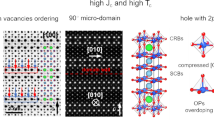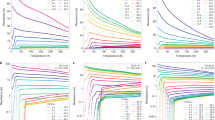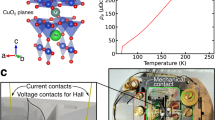Abstract
THE high-transition-temperature (high- Tc) copper oxide superconductors are highly anisotropic in their electrical properties; this is one of the key concerns for applications of these materials, and may also provide a clue to the mechanism of the superconductivity. Although the resistivity in the CuO2 planes, ρab, shows a metallic temperature dependence, the resistivity parallel to the c axis (ρc) has been reported to be both non-metallic1,2 and metallic3,4. Here we present systematic data for ρc in a number of high-Tc materials, obtained from well characterized single crystals. Both the magnitude and the temperature dependence of ρc are strongly dependent on crystal structure, and on the concentration of charge carriers. We find that ρc is non-metallic (dρc/dT< 0) in most superconducting compounds, suggesting an unconventional conduction mechanism. Fully oxygenated YBa2Cu3O∼7 (with Tc≈90K) is the only exception, with a relatively small ρc and positive dρc/d T that may arise from the crystal structure specific to this material.
This is a preview of subscription content, access via your institution
Access options
Subscribe to this journal
Receive 51 print issues and online access
$199.00 per year
only $3.90 per issue
Buy this article
- Purchase on Springer Link
- Instant access to full article PDF
Prices may be subject to local taxes which are calculated during checkout
Similar content being viewed by others
References
Tozer, S. W. et al. Phys. Rev. Lett 59, 1768–1771 (1987).
Hagen, S. J. et al. Phys. Rev. B 37, 7928–7931 (1988).
Iye, Y. et al. Physica C 153–155, 26–31 (1988).
Forro, L. et al. Physica Scripta 41, 365–367 (1990).
Montgomery, H. C. J. appl. Phys. 42, 2971–2975 (1971).
Brawner, D. A., Wang, Z. Z. & Ong, N. P. Phys. Rev. B 40, 9329–9332 (1989).
Kambe, S. et al. Physica C 160, 243–248 (1989).
Hidaka, Y. & Suzuki, M. Nature 338, 635–637 (1989).
Martin, S. et al. Phys. Rev. B 41, 846–849 (1990).
Kadowaki, K., Menovsky, A. A. & Franse, J. J. M. Physica B 165–166, 1159–1160 (1990).
Crommie, M. F. & Zettl, A. Phys. Rev. B 43, 408–412 (1991).
Martin, S. et al. Phys. Rev. Lett. 60, 2194–2197 (1988).
Pickett, W. E. Rev. mod. Phys. 61, 433–510 (1989).
Anderson, P. W. & Zou, Z. Phys. Rev. Lett. 60, 132–135 (1988).
Mott, N. F. Metal-Insulator Transitions, Ch. 1 (Taylor & Francis, New York, 1974).
Author information
Authors and Affiliations
Rights and permissions
About this article
Cite this article
Ito, T., Takagi, H., Ishibashi, S. et al. Normal-state conductivity between CuO2 planes in copper oxide superconductors. Nature 350, 596–598 (1991). https://doi.org/10.1038/350596a0
Received:
Accepted:
Issue Date:
DOI: https://doi.org/10.1038/350596a0
This article is cited by
-
Asymptotically AdS spacetimes with a timelike Kasner singularity
Journal of High Energy Physics (2016)
-
Resistivity anisotropy and charge density wave in 1T-TiSe2
Indian Journal of Physics (2013)
-
New magnetic phase diagram of (Sr,Ca)2RuO4
Nature Materials (2012)
Comments
By submitting a comment you agree to abide by our Terms and Community Guidelines. If you find something abusive or that does not comply with our terms or guidelines please flag it as inappropriate.



